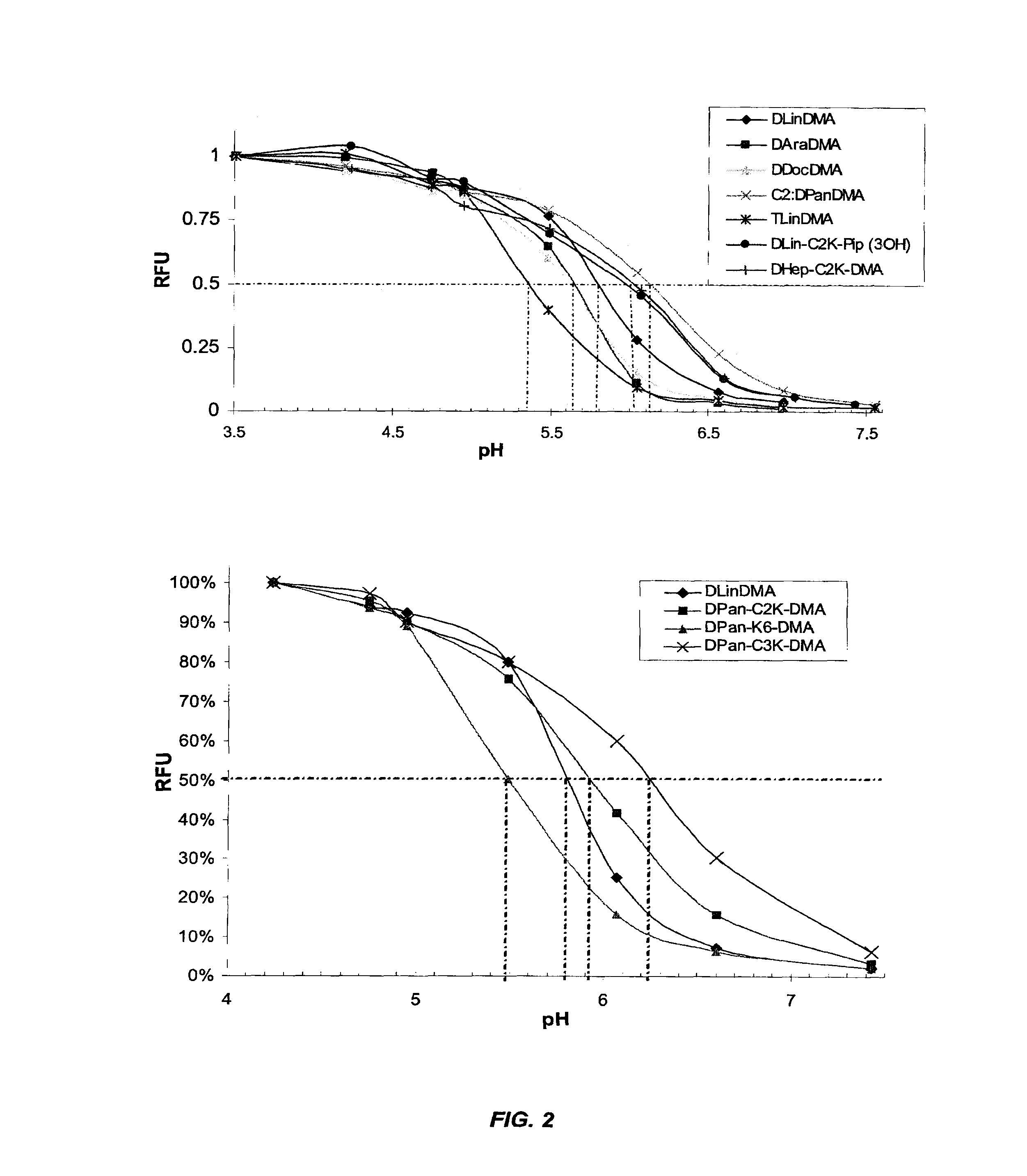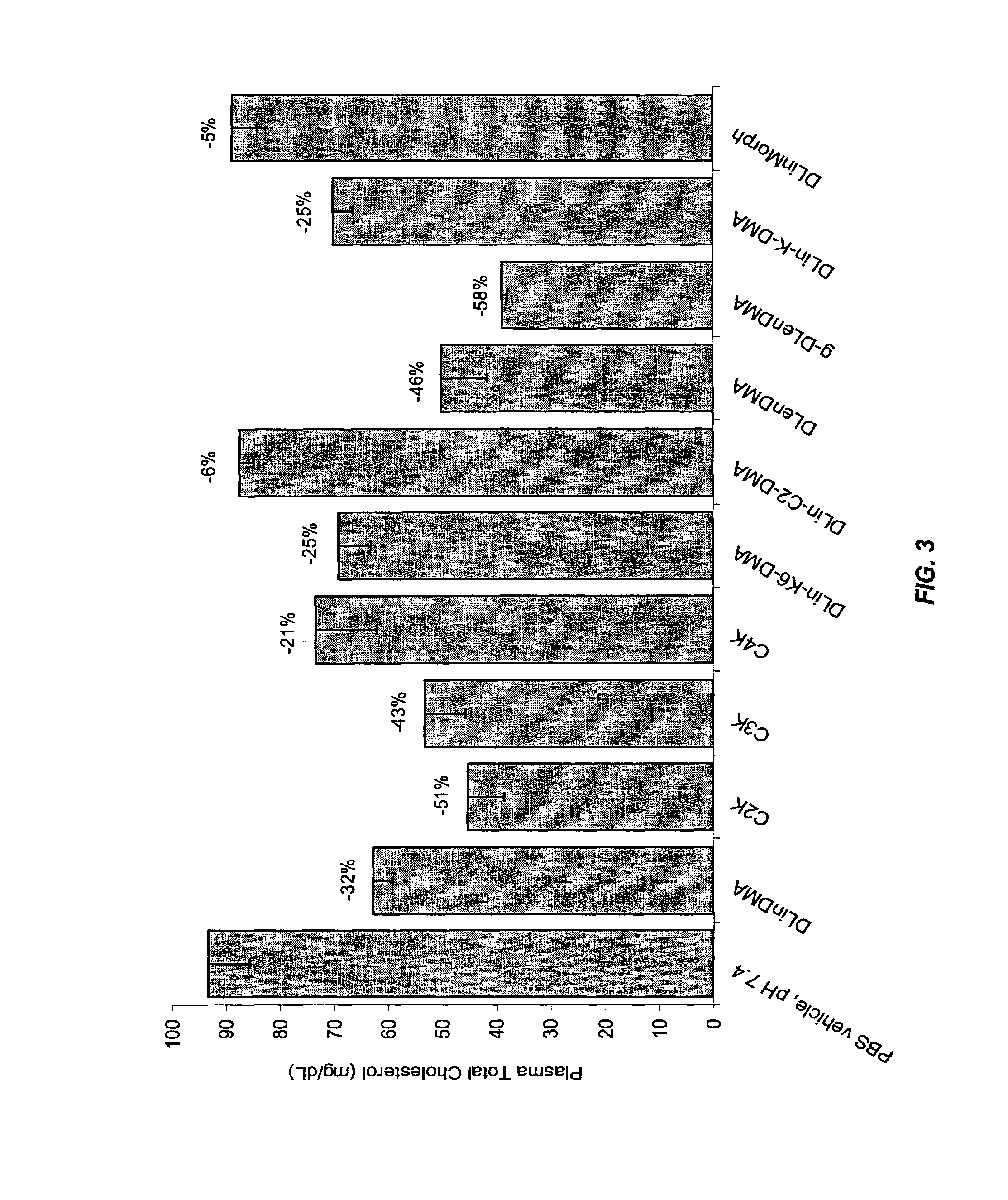Cationic lipids and methods for the delivery of therapeutic agents
a technology of cationic lipids and therapeutic agents, applied in the field of cationic lipids and methods for the delivery of therapeutic agents, can solve the problems of reducing affecting the activity of the construct, and affecting the ability to gain access to the intracellular compartment, so as to achieve the effect of silencing the expression of hepatitis c virus and stable circulation
- Summary
- Abstract
- Description
- Claims
- Application Information
AI Technical Summary
Problems solved by technology
Method used
Image
Examples
example 1
Synthesis of 1,2-Di-γ-linolenyloxy-N,N-dimethylaminopropane (γ-DLenDMA)
[0668]γ-DLenDMA (Compound 1) having the structure shown below was synthesized as described below.
[0669]
[0670]A 250 mL round bottom flask was charged with 3-(dimethylamino)-1,2-propanediol (0.8 g, 6.7 mmol), tetrabutylammonium hydrogen sulphate (1 g), gamma linolenyl mesylate (cis-6,9,12-octadecatriene sulphonic acid) (5 g, 14.6 mmol), and 30 mL toluene. After stirring for 15 minutes, the reaction was cooled to 0-5° C. A solution of 40% sodium hydroxide (15 mL) was added slowly. The reaction was left to stir for approximately 48 hours. An additional 15 mL of toluene was then added to the reaction vessel, along with 40% sodium hydroxide (15 mL). After the reaction was stirred for an additional 12 hours, water (50 mL) and isopropyl acetate (50 mL) were added and stirred for 15 minutes. The mixture was then transferred to a 500 mL separatory funnel and allowed to separate. The lower aqueous phase was run off and the ...
example 2
Synthesis of Asymmetric Cationic Lipids
[0672]Asymmetric cationic lipids (Compounds 4-9) having the structures shown below were synthesized as shown in the following schematic diagram.
[0673]
Step 1: Synthesis of 2-Hydroxy-3-linoleyloxypropylbromide (Compound 2)
[0674]
[0675]A 500 ml round bottom flask was charged with epibromohydrin (5.8 g, 42 mmol), linoleyl alcohol (15 g, 56 mmol), a stir bar, and then flushed with nitrogen. Anhydrous DCM (250 ml) was added via cannula, followed by BF3.Et2O (0.53 ml, 4.2 mmol), and stirred at 40° C. for 3 hours. Progress of reaction was monitored by TLC to ensure no epoxide was remaining. The reaction mixture was transferred to a 500 ml separatory funnel with DCM (2×50 ml), washed with NaHCO3 (2×200 ml), water (200 ml), brine (200 ml), dried with MgSO4, and solvent evaporated. The crude product was purified using column chromatography on silica gel (300 g) with 5-15% ether gradient in hexanes to yield 12.6 g.
Step 2: Synthesis of 2-Hydroxy-3-linoleylox...
example 3
Synthesis of Cationic Lipids of the TLinDMA Family
[0690]The following diagram provides a general scheme for synthesizing members of the C(n)-TLinDMA family of cationic lipids:
[0691]
[0692]TLinDMA (1-(2,3-linoleyloxypropoxy)-2-(linoleyloxy)-(N,N-dimethyl)-propyl-3-amine) (Compound 12) was synthesized as follows:
Synthesis of Compound 10
[0693]A 1000 ml round bottom flask was charged with epibromohydrin (5 g, 37 mmol), glycerol (10 g, 110 mmol), a stir bar and then flushed with nitrogen. Anhydrous chloroform (350 mL) was added via cannula, followed by BF3.Et2O (0.5 mL, 3.7 mmol) and refluxed for 3 hours under nitrogen. The reaction mixture was cooled and subsequently stirred at room temperature overnight. Upon completion of the reaction, the reaction mixture was concentrated and the crude product (15 g) was purified via column chromatography using silica gel (150 g).
Synthesis of Compound 11
[0694]A 500 mL round bottom flask was charged with Compound 10 (3.8 g, 17 mmol) and a stir bar. Aft...
PUM
| Property | Measurement | Unit |
|---|---|---|
| median diameter | aaaaa | aaaaa |
| mol % | aaaaa | aaaaa |
| mol % | aaaaa | aaaaa |
Abstract
Description
Claims
Application Information
 Login to View More
Login to View More - R&D
- Intellectual Property
- Life Sciences
- Materials
- Tech Scout
- Unparalleled Data Quality
- Higher Quality Content
- 60% Fewer Hallucinations
Browse by: Latest US Patents, China's latest patents, Technical Efficacy Thesaurus, Application Domain, Technology Topic, Popular Technical Reports.
© 2025 PatSnap. All rights reserved.Legal|Privacy policy|Modern Slavery Act Transparency Statement|Sitemap|About US| Contact US: help@patsnap.com



